The AMD Ryzen 9 3950X Review: 16 Cores on 7nm with PCIe 4.0
by Dr. Ian Cutress on November 14, 2019 9:00 AM ESTGaming: Grand Theft Auto V
The highly anticipated iteration of the Grand Theft Auto franchise hit the shelves on April 14th 2015, with both AMD and NVIDIA in tow to help optimize the title. GTA doesn’t provide graphical presets, but opens up the options to users and extends the boundaries by pushing even the hardest systems to the limit using Rockstar’s Advanced Game Engine under DirectX 11. Whether the user is flying high in the mountains with long draw distances or dealing with assorted trash in the city, when cranked up to maximum it creates stunning visuals but hard work for both the CPU and the GPU.
For our test we have scripted a version of the in-game benchmark. The in-game benchmark consists of five scenarios: four short panning shots with varying lighting and weather effects, and a fifth action sequence that lasts around 90 seconds. We use only the final part of the benchmark, which combines a flight scene in a jet followed by an inner city drive-by through several intersections followed by ramming a tanker that explodes, causing other cars to explode as well. This is a mix of distance rendering followed by a detailed near-rendering action sequence, and the title thankfully spits out frame time data.
There are no presets for the graphics options on GTA, allowing the user to adjust options such as population density and distance scaling on sliders, but others such as texture/shadow/shader/water quality from Low to Very High. Other options include MSAA, soft shadows, post effects, shadow resolution and extended draw distance options. There is a handy option at the top which shows how much video memory the options are expected to consume, with obvious repercussions if a user requests more video memory than is present on the card (although there’s no obvious indication if you have a low end GPU with lots of GPU memory, like an R7 240 4GB).
All of our benchmark results can also be found in our benchmark engine, Bench.
| AnandTech | IGP | Low | Medium | High |
| Average FPS | 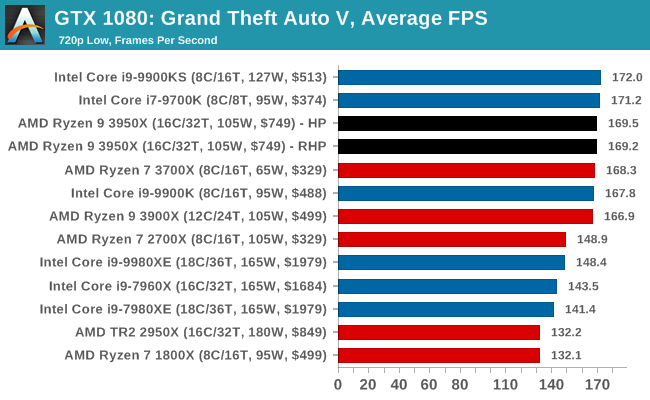 |
 |
 |
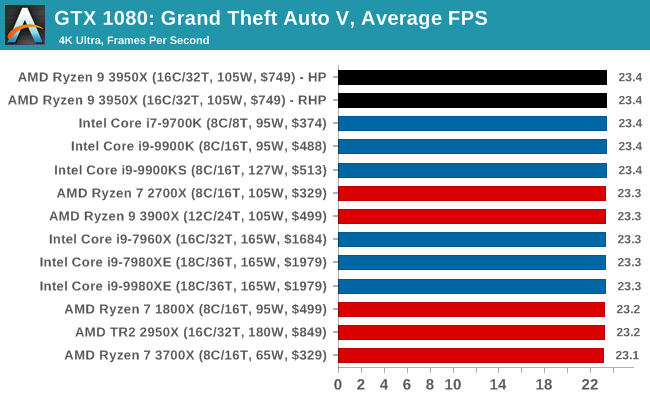 |
| 95th Percentile | 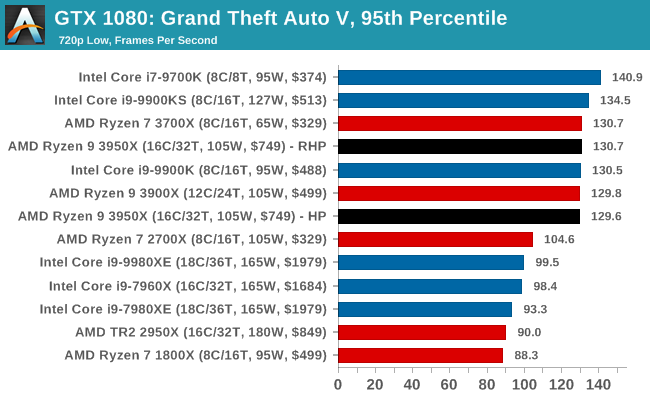 |
 |
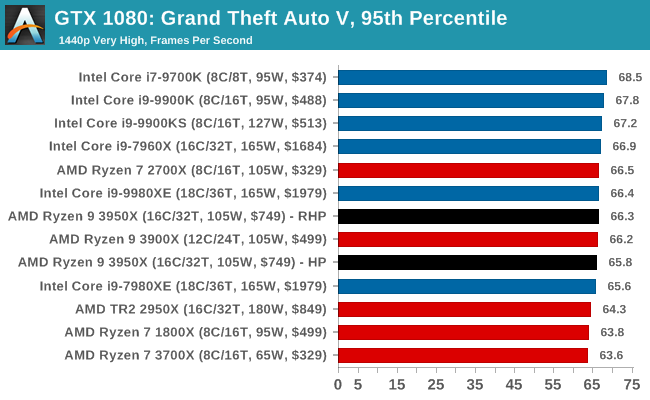 |
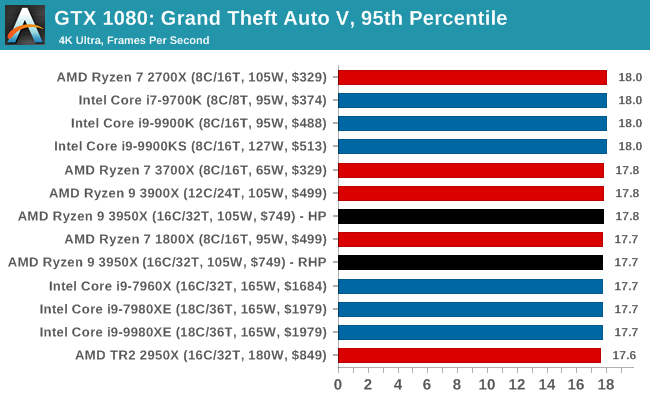 |












206 Comments
View All Comments
Slash3 - Thursday, November 14, 2019 - link
Intel is subsidizing retailer discounts in an effort to smooth over the transition to the newer Cascade Lake-X chips. It's part of their $3B marketing and incentive campaign. Subsequent fulfillment from Intel is at the reduced (but unofficial) lower pricing.https://www.computerbase.de/2019-10/high-end-cpu-i...
Intel gets to clear remaining stock and retailers avoid taking a bath on previously purchased CPUs. Makes sense.
Spunjji - Thursday, November 14, 2019 - link
If retailers had to drop prices that much to clear stock and Intel weren't chipping in to compensate, we'd definitely be hearing about it.Phynaz - Thursday, November 14, 2019 - link
Intel will be price protecting them.Ratman6161 - Thursday, November 14, 2019 - link
Personal opinion from someone who is NOT in the HEDT market: People whose work/Livelihood comes from tasks that are noticeably better on an HEDT platform, probably don't care about the price or at least don't care as much as the rest of us do. All the math works out differently if you can actually take advantage of the things other than the CPU that HEDT offers. So I think there is still a pretty firm dividing line between x299 and thread ripper on one side and everything else in this test on the other.Just saying that price only becomes a deciding factor AFTER you decide which side of that line you are on.
AIV - Thursday, November 14, 2019 - link
3950X blurs the line between HEDT and Desktop market. New 16 core EPYC rome (e.g 7302P is less than 1000EUR) along threadripper makes the market segmentation even more blurry. Especially at ~16 cores there are many alternatives in multiple product families.phoenix_rizzen - Thursday, November 14, 2019 - link
Yeah, you can now start mixing and matching CPUs based on your other needs (PCIe lanes, I/O support, memory channels, memory speeds, graphics, etc).Ryzen CPUs give you dual-channel memory and 24 (16+4+4) PCIe lanes.
Threadripper CPUs give you quad-channel memory and 88 (64+16+8) PCIe lanes.
EPYC CPUs give you octo-channel memory and 128 PCIe lanes.
Figure out how much memory and I/O you need, then choose the CPU with the number of cores you want.
From 2-core Athlons with integrated graphics to 64-core monsters, there's plenty of choices along the way. :)
8-core Ryzen 7
8-core EPYC
12-core Ryzen 9
12-core EPYC
16-core Ryzen 9
16-core Threadripper
16-core EPYC
24-core Threadripper
24-core EPYC
32-core Threadripper
32-core EPYC
lobz - Thursday, November 14, 2019 - link
It's still a bad deal for that price. That CPU is on a dead platform.Phynaz - Thursday, November 14, 2019 - link
Kinda like Threadripper, eh?yeeeeman - Thursday, November 14, 2019 - link
This CPU basically renders Intel CPU until 1000$ useless. Only 9900KS brings something extra in gaming and general app usage. Threadripper will do the same for higher end 1000$+ market. This is the first time in many many years when AMD is better in pretty much all price categories, period.Total Meltdowner - Thursday, November 14, 2019 - link
Glad I bought AMD Stock 3 years ago. Wish I had invested more... sigh.